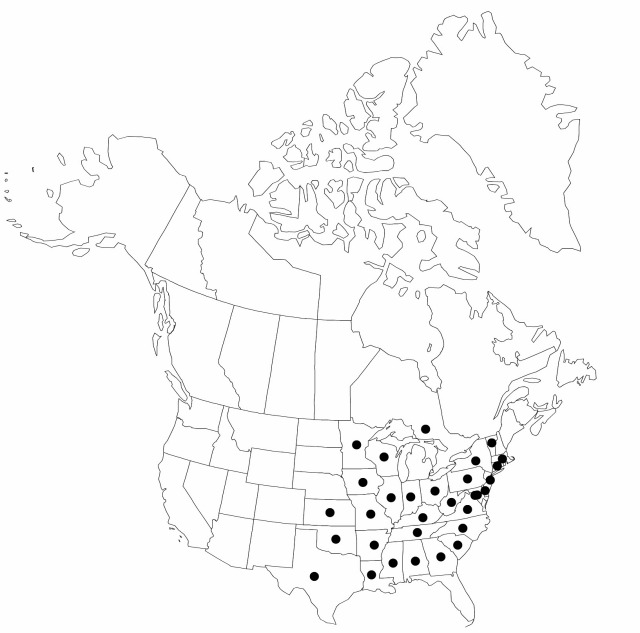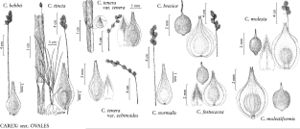Carex festucacea
Sp. Pl. 4(1): 242. 1805.
Plants cespitose. Culms 45–100 cm; vegetative culms few, inconspicuous, usually fewer than 15 leaves, not strikingly 3-ranked, leaves clustered at apex. Leaves: sheaths green or with white intervenal areas, often adaxially white-hyaline, summits U-shaped or prolonged to 2 mm beyond collar; sheaths finely papillose or smooth; distal ligules 1–3 mm; blades 3–5 per fertile culm, 15–30 cm × 1–3.5 mm. Inflorescences arching or nodding, ± open, green to light-brown, 2.5–6 cm × 4.5–11 mm; proximal internode 3–18 mm; 2d internode 3–13 mm; proximal bracts scalelike or with bristle tips shorter than inflorescences. Spikes 3–10, distinct, ellipsoid to globose, 6–16 × 5–6.5 mm, base acute to attenuate, apex rounded; terminal spike with conspicuous staminate base. Pistillate scales white-hyaline with white, green, or gold center, broadly lanceolate, 2.3–3.8 mm, shorter than and narrower than perigynia, apex acute. Anthers 1–2.1 mm. Perigynia (20–) 25–60 in larger spikes, spreading, pale green to yellowish-brown, conspicuously 5-veined or more abaxially, veinless or mostly indistinctly or basally 2–4 (–6) -veined adaxially, orbiculate to elliptic, planoconvex, 2.5–4.2 × 1.5–2.3 (–2.5) mm, 0.4–0.6 mm thick, nearly leathery, margin flat, including wing 0.3–0.6 mm wide, smooth; beak green or light-brown at tip, flat, ciliate-serrulate, abaxial suture with conspicuous white-hyaline margin, distance from beak tip to achene 0.8–1.7 (–2) mm. Achenes ovate, 1.2–1.8 × 1–1.3 mm, 0.3–0.4 mm thick; style sometimes abaxially-adaxially bent at base. 2n = 68, 70.
Phenology: Fruiting late spring–early summer.
Habitat: Wet or seasonally wet places, poorly drained fields, open woods
Elevation: 100–300 m
Distribution

Ont., Ala., Ark., Conn., Del., D.C., Ga., Ill., Ind., Iowa, Kans., Ky., La., Md., Mass., Minn., Miss., Mo., N.J., N.Y., N.C., Ohio, Okla., Pa., S.C., Tenn., Tex., Vt., Va., W.Va., Wis.
Discussion
Carex festucacea is often confused with 148. C. albolutescens; see note under that species.
Selected References
None.
Lower Taxa
"shortened" is not a number."narrower" is not a number."+timesaslongasinflorescences" is not declared as a valid unit of measurement for this property."not undefined" is not a number.
